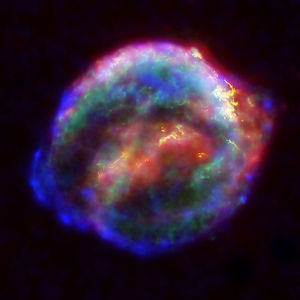Supernovae originate from dying red supergiant stars
 Washington, March 20 : A team of scientists has confirmed the origin of supernovae as being produced from dying red supergiant stars.
Washington, March 20 : A team of scientists has confirmed the origin of supernovae as being produced from dying red supergiant stars.
The scientists are from the Dark Cosmology Centre at the Niels Bohr Institute, University of Copenhagen and from Queens University, Belfast.
A star is a large ball of hot gas and in its incredibly hot interior hydrogen atoms combine to form helium, which subsequently forms carbon, other heavier elements and finally iron.
When all the atoms in the centre have turned to iron the fuel is depleted and the star dies.
When very large and massive stars, that are at least about eight times as massive as our sun, die, they explode as supernovae.
But, some massive stars become red supergiant stars first, which is an intermediate phase where, after the fuel in the centre is used up, energy is still produced in shells surrounding the now dead core.
In this phase, the star swells up to an enormous size, approximately 1500 times larger than the sun, and emits as much light as a hundred thousand suns.
But, there has been doubt over whether red supergiants explode as supernovae.
Using images from the Hubble Space Telescope and the Gemini Observatory, Justyn R. Maund, astrophysicist at the Dark Cosmology Centre, Niels Bohr Institute, University of Copenhagen and astrophysicist Stephen J. Smartt, Queens University Belfast, have observed two stars that exploded as supernovae.
By analyzing archival images of the same section of the sky from long before the explosions, the researchers could see which stars might have gone supernova.
But, picking out individual stars in the distant universe is difficult, and pinpointing exactly which star it was that exploded is a huge challenge.
A supernova is visible in the sky for some time after its explosion before its giant dust - and gas clouds are blown clear.
The researchers can then observe the region around the position of the supernova several years after the supernova explosion and can then see exactly which star has disappeared.
For one of the supernovae, SN1993J (which exploded in 1993) they found that a red supergiant no longer exists, but that its neighboring star remained.
In addition, they found that the red supergiant that was postulated to have caused the supernova SN2003gd has also disappeared.
This time intensive method establishes that it was these two red supergiant stars that produced the supernovae 2003J and 2003gd, and confirms that red supergiant stars create type II supernovae.
So, Maund and Smartt have found the missing link between red supergiant stars and their supernovae, giving astronomers a greater understanding of how massive stars die. (ANI)